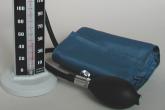Conference Coverage


The long slog toward release of revised U.S. guidelines for treating hypertension may end in September. Or not.
Authoritative U.S. guidelines for managing high blood pressure have traveled a rocky and serpentine path ever since the expert group originally constituted as the Eighth Joint National Committee (JNC 8) released its controversial report in early 2014, when it relaxed the target blood pressure for most adults aged 60-79 years from less than 140 mm Hg to under 150/90 mm Hg (JAMA. 2014 Feb 5;3311[5]:507-20). A few months before those recommendations came out, the National Heart, Lung, and Blood Institute, which since 1977 had organized seven preceding iterations of U.S. blood pressure guidelines, handed off oversight of the project and any future updates to the American Heart Association, the American College of Cardiology, and the American Society of Hypertension. A year later, an expert panel organized by those three groups reset the blood pressure target for most U.S. adults with coronary artery disease back to a pressure of less than 140/90 mm Hg (Hypertension. 2015 Jun;65[6]:1372-1407), and that has been the prevailing U.S. standard in the 2-plus years since.
A few months later, in September 2015, data from the SPRINT trial in more than 9,000 patients with high cardiovascular risk first came out and showed that treating to a target systolic blood pressure of less than 120 mm Hg led to a significant 25% reduction in cardiovascular disease events, compared with controls treated to a systolic pressure of less than 140 mm Hg (N Engl J Med. 2015 Nov 26;373[22]:2103-16). Ever since, the big question surrounding blood pressure targets in U.S. practice has been, when would new official guidelines emerge that took the SPRINT findings into consideration? It now looks like it will finally happen in September 2017.
That’s when the ASH and the AHA’s Hypertension Council will for the first time hold a joint annual meeting, after many years when each organization had its own, individual annual meeting. The ASH’s traditional spring meeting didn’t happen this year; early fall has traditionally been when the AHA’s Hypertension Council meets.
The Council’s posted preliminary program for the September meeting showed, as of late July, an opening session the morning of September 14 called a “Review of AHA Scientific Statement 2017.” On the ASH’s website is a virtual flier for a session the afternoon of September 15 on the “2017 Guidelines for Adult and Pediatric Hypertension.”
I asked Daniel T. Lackland, DrPH, if this means the new guidelines will come out just before or concurrent with these two sessions. In addition to being a professor of medicine at the Medical University of South Carolina in Charleston and a hypertension epidemiologist, Dr. Lackland serves on the current guidelines panel, cochaired the panel that reported in 2015, and was also a member of the 2014 committee that called itself the group “appointed to the JNC 8.”“I know that something will be discussed on September 14,” he told me recently. “I am not sure the full report will be ready then, but I think something will be presented that will at least describe the ‘attitude’ of the guidelines, if not the whole report. There will be more presented at the AHA Sessions in November.” Of course, there will also be “an accompanying evidence document describing the studies and evidence that generated the report, but I don’t know the release date,” he added.
Some of the suspense is already gone from the new guidelines, because the punch line – the new target blood pressure to treat toward for most U.S. adults with hypertension – is already known to be less than 130/80 mm Hg. That was the treatment goal set in April in updated guidelines for treating patients with heart failure by a panel of the ACC, the AHA, and the Heart Failure Society of America (J Am Coll Cardiol. 2017 Apr 30. doi: 10.1016/j.jacc.2017.04.025). Among the heart failure patients subject to this blood pressure target are adults with stage A heart failure, which the panel defined as any adult diagnosed with hypertension, as well as those with diabetes, coronary artery disease, or other risk factors that clearly predispose patients to develop heart failure.
Last April, the heart failure panel’s vice-chair, Mariell Jessup, MD, told me that the group chose a treatment target of less than 130/80 mm Hg to “harmonize” with the target that the hypertension guideline group had already selected.
So, in truth, an official U.S. hypertension treatment target of less than 130/80 mm Hg is already on the books for clinicians to follow that’s endorsed by the ACC and AHA. Unless the hypertension group throws a real curve ball its target will be identical.
But just knowing this lower target leaves important questions unanswered that presumably the hypertension panel will address. Questions like the best drug combinations to use to get blood pressures this low, and how aggressively to treat older patients with comorbidities who may need upward of four drugs to achieve a systolic blood pressure in this target range.
“I suspect some will say that the heart failure guidelines are for patients with heart failure, and thus the hypertension guidelines will complement them,” said Dr. Lackland. On the other hand, the SPRINT evidence is so persuasive that at least “some physicians will move to 130/80 mm Hg” readily, he predicted. “Others will probably wait and see, and some will wait even longer for follow-up comments” to come out.
Dr. Lackland also stressed the usual caveat about any medical guideline, that both the heart failure and hypertension statements simply give clinicians the recommended approach but “should not override clinical judgment for specific patients.”
But before the medical community can embrace or question the new hypertension guidelines it needs to at least see them. That finally seems ready to happen in September, and perhaps in November too.
On Twitter @mitchelzoler


